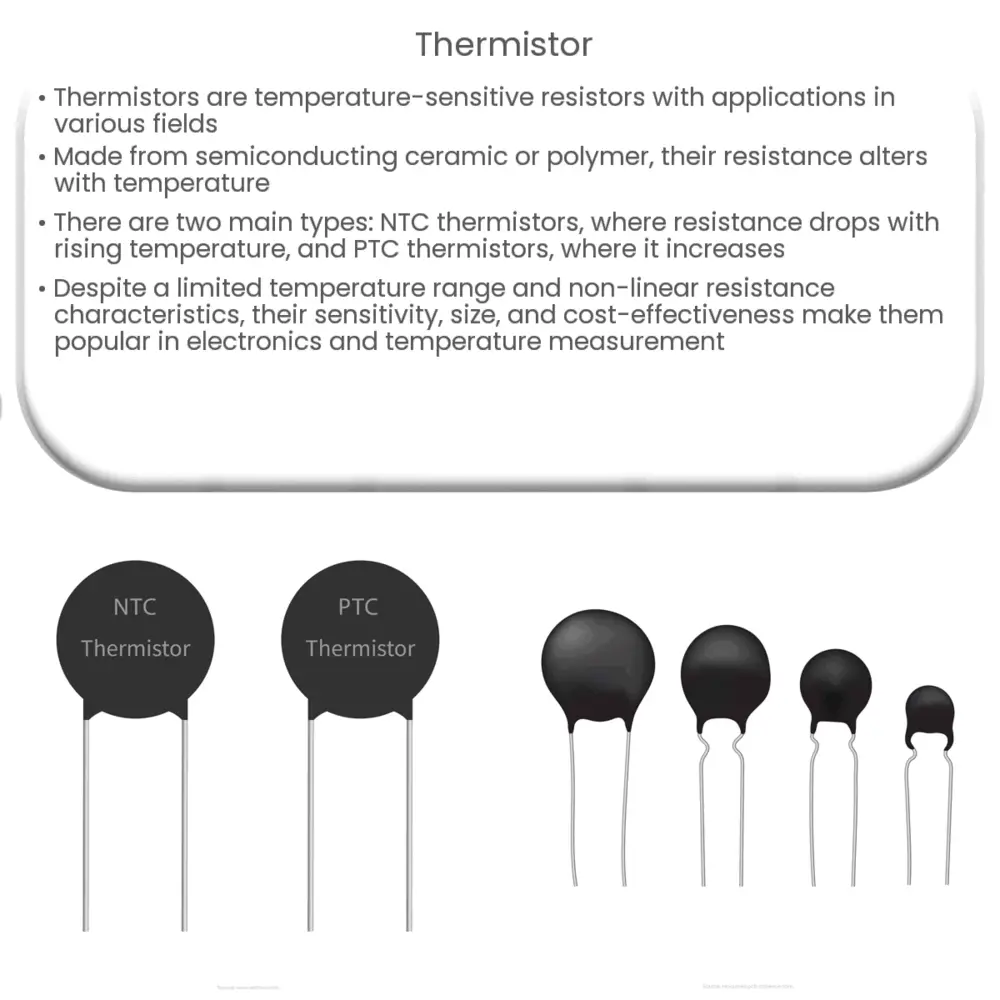Explore the world of thermistors, their construction, types, working principle, and applications in various fields. Learn about their advantages, limitations, and integration in electronics.

Introduction to Thermistors
A thermistor is a type of resistor whose resistance is greatly influenced by temperature changes. The term ‘thermistor’ itself is a portmanteau of ‘thermal’ and ‘resistor’. These temperature-sensitive resistors have a variety of applications in many fields, including consumer electronics, industrial systems, and scientific research.
Construction and Types of Thermistors
Thermistors are typically made from ceramic or polymer materials that are semiconducting in nature. These materials are shaped into discs, rods, or bead-like structures and then encapsulated in glass or epoxy. As their temperature changes, so does their resistance, and this unique characteristic is what makes thermistors so useful.
There are two primary types of thermistors: Negative Temperature Coefficient (NTC) and Positive Temperature Coefficient (PTC). The key difference between these two types is the direction in which their resistance changes with temperature.
- NTC Thermistors: With NTC thermistors, resistance decreases as temperature increases. These are the most commonly used type of thermistor and are often used for temperature measurement and control.
- PTC Thermistors: Conversely, PTC thermistors exhibit an increase in resistance as temperature increases. These are often used in circuit protection applications, as they can limit current in a circuit when a certain temperature is exceeded.
Working Principle of Thermistors
The underlying principle behind the operation of a thermistor is the change in resistance of the thermistor’s material with temperature. This change is due to the increase or decrease in the number of charge carriers available within the material. As temperature changes, the material’s resistance changes in a predictable and repeatable manner. This change can be mapped as a thermistor’s ‘resistance-temperature’ characteristic curve.
Applications of Thermistors
Thermistors find widespread use across a range of applications, thanks to their accuracy, small size, and cost-effectiveness. They are commonly used in applications where precise temperature measurements are required.
- In temperature sensors: Thermistors are often used in electronic devices such as digital thermometers, automotive systems, and home appliances like ovens and refrigerators.
- In circuits protection: PTC thermistors can be used as self-resetting fuses, protecting circuits from damaging overcurrent situations.
Advantages and Limitations of Thermistors
Thermistors offer several advantages that make them an ideal choice for certain applications. They are highly sensitive to temperature changes, providing rapid response times. Their small size allows them to be used in applications where space is a constraint. Furthermore, they are relatively inexpensive and easy to produce.
However, they also have their limitations. For one, thermistors generally have a limited temperature range compared to other types of temperature sensors. They also exhibit non-linear resistance-temperature characteristics, which can complicate the measurement and control process.
Interfacing Thermistors with Electronics
Interfacing a thermistor with electronics typically involves a simple circuit where the thermistor is connected in series with a resistor. The voltage across the thermistor can then be measured and used to determine the temperature based on the known resistance-temperature characteristic of the thermistor. However, because of the non-linear nature of thermistor characteristics, the conversion from voltage to temperature can involve complex calculations, and digital systems like microcontrollers are often used for this purpose.
- In digital systems: Thermistors can be interfaced with microcontrollers using an Analog-to-Digital Converter (ADC) to measure the voltage across the thermistor.
- In analog systems: Thermistors can be used in simple analog circuits, but these are less common due to the non-linear nature of the thermistor’s resistance-temperature characteristics.
Conclusion
In conclusion, thermistors are a crucial component in many electronic devices and systems. Their ability to accurately measure temperature and control circuits has led to their widespread adoption in numerous applications. While they do have limitations, such as a limited temperature range and non-linear resistance characteristics, their advantages often outweigh these limitations. As technology continues to evolve, it is expected that the use and application of thermistors will continue to grow and diversify.



